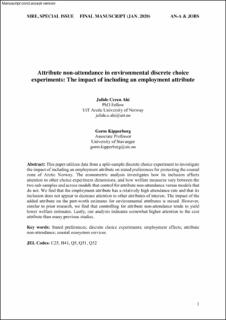| dc.contributor.author | Ahi, Julide Ceren | |
| dc.contributor.author | Aanesen, Margrethe | |
| dc.contributor.author | Kipperberg, Gorm | |
| dc.date.accessioned | 2023-04-04T09:14:43Z | |
| dc.date.available | 2023-04-04T09:14:43Z | |
| dc.date.created | 2022-12-07T15:20:45Z | |
| dc.date.issued | 2022 | |
| dc.identifier.citation | Ahi, J. C., Aanesen, M., & Kipperberg, G. (2023). Testing the sensitivity of stated environmental preferences to variations in choice architecture. Ecological Economics, 205, 107680. | en_US |
| dc.identifier.issn | 0921-8009 | |
| dc.identifier.uri | https://hdl.handle.net/11250/3062001 | |
| dc.description.abstract | We conducted a three-way split sample discrete choice experiment (DCE) to investigate welfare estimates for attributes related to the management of coastal cod stocks in Arctic Norway. In a base DCE design, respondents faced three core attributes: (1) coastal cod spawning biomass as an indicator of the sustainability of the cod stocks, (2) stricter regulations on primary user groups (commercial fishers, local recreational anglers, the marine fishing tourism industry), and (3) annual household cost. In two experimentally varied DCE designs, respondents received a fourth attribute that explicitly describes the expansion of the marine fishing tourism industry in the region. In treatment 1, the expansion is represented by the number of coastal cod caught by marine fishing tourists as an indicator of the industry's environmental impact. In treatment 2, the expansion is represented by the number of new jobs as an indicator of the industry's socioeconomic impact. These two attribute translations, designed to be perfectly correlated, serve as an instrument for testing a choice architecture - value activation framework recently proposed in the management science literature. Mixed logit estimation results indicate that welfare estimates vary significantly across choice architectures, both statistically and economically. Additional regression analyses of conditional welfare estimates and respondents' status quo choices yield mixed evidence of value activation. The overall message of the study is that DCE researchers should be cognizant of their role as choice architects when advising public resource managers and policymakers. | en_US |
| dc.language.iso | eng | en_US |
| dc.publisher | Elsevier | en_US |
| dc.title | Testing the sensitivity of stated environmental preferences to variations in choice architecture | en_US |
| dc.type | Peer reviewed | en_US |
| dc.type | Journal article | en_US |
| dc.description.version | acceptedVersion | en_US |
| dc.rights.holder | The owners/authors | en_US |
| dc.subject.nsi | VDP::Samfunnsvitenskap: 200 | en_US |
| dc.source.pagenumber | 17 | en_US |
| dc.source.volume | 205 | en_US |
| dc.source.journal | Ecological Economics | en_US |
| dc.identifier.doi | 10.1016/j.ecolecon.2022.107680 | |
| dc.identifier.cristin | 2090235 | |
| dc.relation.project | Norges forskningsråd: 267834 | en_US |
| cristin.ispublished | true | |
| cristin.fulltext | postprint | |
| cristin.qualitycode | 1 | |
